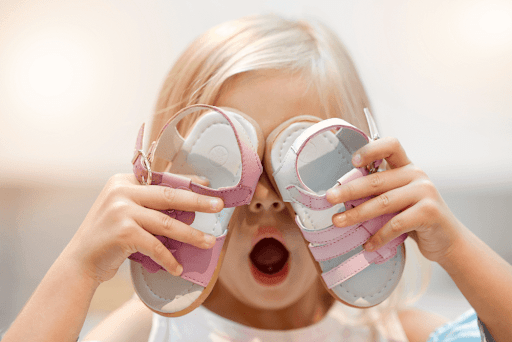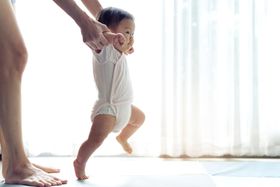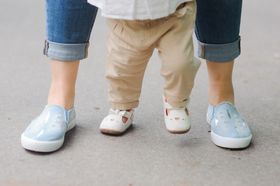Why Toddlers Walk on Tippy Toes: Is It Normal or a Concern?
Tippy-toe toddlers—is it a phase or a problem? Learn when to worry about your child's walking style
Updated December 5, 2024.

Watching your toddler navigate the world on their tippy toes can be charming and puzzling. This distinctive walking pattern, known as toe walking, is a common phenomenon that raises many questions for parents and caregivers.
Let's explore this fascinating aspect of childhood development and understand when it's simply a phase and when it might need professional attention.
» Support your child's foot health with shoes designed for toe walking
What Is Toe Walking?
During their early years of exploration, some toddlers adopt toe walking, particularly if they find it enjoyable or stimulating to their senses. This is typically noticed when kids first begin walking and can persist through the early toddler years.
Many children naturally alternate between regular and toe walking, especially when excited or running. This variation in walking patterns is usually not cause for concern as long as the child can walk flat-footed when asked or when focusing on their movement.
» Support their adventures with the best walking shoes for kids
Why Does My Child Walk on Tippy Toes?
The reasons behind toe walking can range from simple developmental preferences to more complex underlying conditions. Common causes include:
- Developmental Phase: Many toddlers experiment with toe walking as part of their normal developmental progression.
- Sensory Processing Differences: Some children may find toe walking more comfortable or stimulating due to sensory sensitivities.
- Muscle Tightness: Tight calf muscles or shortened Achilles tendons can limit ankle flexibility, making achieving a normal heel strike difficult.
- Neurological Conditions: Sometimes, toe walking may be associated with underlying neurological conditions like cerebral palsy or autism spectrum disorder.
If your child's toe walking persists beyond the toddler years or is accompanied by other developmental delays, it's important to consult a paediatrician or orthopaedic specialist.
» Learn if there a connection between ADHD and toe walking
When Should Parents Be Concerned?
The transition from normal developmental toe walking to a potential concern isn't always clear-cut, but there are specific indicators that parents should watch for. Key warning signs include:
- Inability to walk flat-footed when asked or during focused activities
- Complaints of pain or discomfort in the legs, feet, or back
- Noticeable muscle tightness in the calves or difficulty stretching the feet
- Associated delays in other areas of motor development
When assessing concerns, healthcare providers often look for patterns in toe-walking behaviour and consider overall developmental progress.
» Understand the connection between toe walking and autism
Physical Impact of Toe Walking
Persistent toe walking affects multiple body systems and can lead to various physical challenges if not addressed appropriately. The impact begins in the feet and ankles but can extend throughout the kinetic chain, affecting posture, balance, and overall movement patterns.
Immediate physical effects include:
- Increased muscle tension in the calves and Achilles' tendons
- Altered weight distribution across the feet
- Modified balance patterns that may affect stability
Long-term consequences may involve:
- Persistent muscle shortening that requires therapeutic intervention
- Development of compensatory movement patterns
- Potential impacts on joint alignment and function
» Discover the best supportive sneakers for active playtimes
How Proper Footwear Can Help
Selecting appropriate footwear is crucial in supporting proper walking development and addressing toe-walking concerns. The right shoes can provide essential support while letting natural movement patterns develop.
Good shoes contribute to:
- Balanced Development: Proper footwear helps distribute weight evenly across the foot, preventing overuse injuries and promoting balanced muscle development in the legs and feet.
- Stronger Foundation: By supporting a natural heel-to-toe gait, these shoes help build a strong foundation for future physical activity and overall health.
- Enhanced Body Awareness: The right footwear provides essential sensory feedback, improving a child's body awareness and coordination.
- Improved Motor Skills: With better proprioception, children can refine their motor skills, such as walking, running, and jumping.
- Boosted Confidence: Comfortable and supportive footwear can boost a child's self-confidence, encouraging them to explore and engage with their environment.
» Learn how to pick shoes for different stages of foot development
Essential features in supportive footwear include:
- Flexible soles that allow natural foot movement while providing necessary support
- Structured heel counters that encourage heel-strike during walking
- Adequate ankle support without restricting normal range of motion
- Comfortable fit that accommodates natural foot growth and movement
How To Manage Toe Walking
A comprehensive movement program can help strengthen muscles, improve flexibility, and promote proper walking patterns. These activities should be enjoyable and age-appropriate while focusing on specific therapeutic goals.
Try these helpful activities:
- Gentle stretching exercises for the calves and Achilles' tendons
- Balance activities that encourage full foot contact
- Play-based movements that naturally promote heel-toe walking
- Structured exercises prescribed by physical therapists when needed
» Check out why orthopaedic shoes are a game-changer for kids
Professional Support and Intervention
When toe walking persists or causes concern, professional intervention may be necessary. Healthcare providers can offer comprehensive evaluation and targeted treatment approaches. Early intervention often leads to better outcomes and can prevent long-term complications.
Common professional interventions include:
- Physical therapy assessment and treatment planning
- Orthotic devices or specialised footwear recommendations
- Developmental evaluation to address underlying concerns
- Behavioural interventions when appropriate
» See what shoes podiatrists approve for kids
Moving Forward with Confidence
Understanding and addressing toe walking requires patience, observation, and, sometimes, professional guidance. While many kids naturally develop mature walking patterns, others may need additional support and intervention. Maintaining a balanced approach that considers developmental norms and individual needs is key.
Specialised shoes can be a valuable asset in supporting your tippy-toe kid. Their firm ankle support and reinforced heel cups provide stability, while the flexible soles encourage a natural heel-to-toe gait. By guiding the foot into proper alignment, First Walkers can help reduce the risk of future foot problems.
» Find the perfect fit for your toe-walking little one
Disclaimer: First Walkers' information is intended for educational and informational purposes related to toddler footwear and feet. We encourage you to consider individual circumstances and consult qualified orthopaedists about specific conditions.






